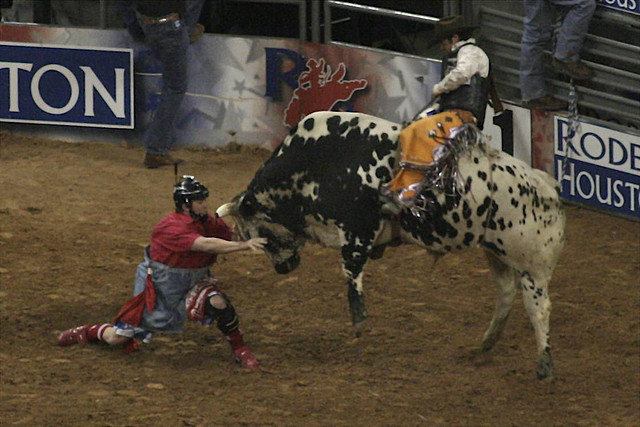Posts Tagged ‘Fear’
Sometimes things need to get worse before they can get better.
 All the scary words are grounded in change. Innovation, by definition, is about change. When something is innovative it’s novel, useful and successful. Novel is another word for different and different means change. That’s why innovation is scary. And that’s why radical innovation is scarier.
All the scary words are grounded in change. Innovation, by definition, is about change. When something is innovative it’s novel, useful and successful. Novel is another word for different and different means change. That’s why innovation is scary. And that’s why radical innovation is scarier.
Continuous improvement, where everything old is buffed and polished into something new, is about change. When people have followed the same process for fifteen years and then it’s improved, people get scared. In their minds improved isn’t improved, improved is different. And different means change. Continuous improvement is especially scary because it makes processes more productive and frees up people to do other things, unless, of course, there are no other things to do. And when that happens their jobs go away. Every continuous improvement expert knows when the first person loses their job due to process improvement the program is dead in the saddle, yet it happens. And that’s scary on a number of fronts.
And then there’s disruption. While there’s disagreement on what it actually is, there is vicious agreement that after a disruption the campus will be unrecognizable. And unrecognizable things are unrecognizable because they are different from previous experience. And different means change. With mortal innovation there are some limits, but with disruption everything is fair game. With disruption everything can change, including the venerable, yet decrepit, business model. With self-disruption, the very thing responsible for success is made to go away by the people that that built it. And that’s scary. And when a company is disrupted from the outside it can die. And, thankfully, that’s scary.
But change isn’t scary. Thinking about change is scary.
There’s one condition where change is guaranteed – when the pain of the current situation is stronger than the fear of changing it. One source of pain could be from a realization the ship will run aground if a new course isn’t taken. When pain of the immanent shipwreck (caused by fear) overpowers the fear of uncharted waters, the captain readily pulls hard to starboard. And when the crew realizes it’s sink or swim, they swim.
Change doesn’t happen before it’s time. And before things get bad enough, it’s not time.
When the cruise ship is chugging along in fair seas, change won’t happen. Right before the fuel runs out and the generators quit, it’s all you can eat and margaritas for everyone. And right after, when the air conditioning kicks out and the ice cream melts, it’s bedlam. But bedlam is not the best way to go. No sense waiting until the fuel’s gone to make change. Maybe someone should keep an eye the fuel gauge and let the captain know when there’s only a quarter tank. That way there’s some time to point the ship toward the closest port.
There’s no reason to wait for a mutiny to turn the ship, but sometimes an almost mutiny is just the thing.
As a captain, it’s difficult to let things get worse so they can get better. But if there’s insufficient emotional energy to power change, things must get worse. The best captains run close to the reef and scrape the hull. The buffet tables shimmy, the smoked salmon fouls the deck and the liquor bottles rattle. And when done well, there’s a deep groan from the bowels of the ship that makes it clear this is no drill. And if there’s a loud call for all hands on deck and a cry for bilge pumps at the ready, all the better.
To pull hard in a new direction, sometimes the crew needs help to see things as they are, not as they were.
Image credit – Francis Bijl
Where there’s fun there is no fear.
 For those who lead projects and people, failure is always lurking in the background. And gone unchecked, it can hobble. Despite best efforts to put a shine on it, there’s still a strong negative element to failure. No two ways about it, failure is mapped with inadequacy and error. Failure is seen as the natural consequence of making a big mistake. And there’s a finality to failure. Sometimes it’s the end of a project and sometimes it’s the end of a career. Failure severely limits personal growth and new behavior. But at least failure is visible to the naked eye. There’s no denying a good train wreck.
For those who lead projects and people, failure is always lurking in the background. And gone unchecked, it can hobble. Despite best efforts to put a shine on it, there’s still a strong negative element to failure. No two ways about it, failure is mapped with inadequacy and error. Failure is seen as the natural consequence of making a big mistake. And there’s a finality to failure. Sometimes it’s the end of a project and sometimes it’s the end of a career. Failure severely limits personal growth and new behavior. But at least failure is visible to the naked eye. There’s no denying a good train wreck.
A fumble is not failure. When something gets dropped or when a task doesn’t get done, that’s a fumble. A fumble is not catastrophic and sometimes not even noteworthy. A fumble is mapped with a careless mistake that normally doesn’t happen. No real cause. It just happens. But it can be a leading indicator of bigger and badder things to come, and if you’re not looking closely, the fumble can go unnoticed. And the causes and conditions behind the fumble are usually unclear or unknown. Where failure is dangerous because everyone knows when it happens, fumbles are dangerous because they can go unnoticed.
Floundering is not fumbling. With floundering, nothing really happens. No real setbacks, no real progress, no real energy. A project that flounders is a project that never reaches the finish line and never makes it to the cemetery. To recognize floundering takes a lot of experience and good judgment because it doesn’t look like much. But that’s the point – not much is happening. No wind in the sails and no storm on the horizon. And to call it by name takes courage because there are no signs of danger. Yet it’s dangerous for that very reason. Floundering can consume more resources than failure.
Fear is the fundamental behind failing, fumbling and floundering. But unlike failure, no one talks about fear. Talking about fear is too scary. And like fumbling and floundering, fear is invisible, especially if you’re not looking. Like diabetes, fear is a silent killer. And where diabetes touches many, fear gets us all. Fear is invisible, powerful and prolific. It’s a tall order to battle the invisible.
But where there’s fun there can be no fear. More precisely, there can be no negative consequence of fear. When there’s fun, everyone races around like their hair is on fire. Not on fire in the burn unit way, but on fire in the energy to burn way. When there’s fun people help each other for no reason. They share, they communicate and they take risks. When there’s fun no one asks for permission and the work gets done. When there’s fun everyone goes home on time and their spouses are happy. Fun is easy to see, but it’s not often seen because it’s rare.
If there’s one thing that can go toe-to-toe with fear, it’s fun. It’s that powerful. Fun is so powerful it can turn failure into learning. But if it’s so powerful, why don’t we teach people to have fun? Why don’t we create the causes and conditions so fun erupts?
I don’t know why we don’t promote fun. But, I do know fun is productive and fun is good for business. But more important than that, fun is a lot of fun.
Image credit – JoshShculz
Dangerous Expectations
 Expectations result from mental models and wants. When you have a mental model of a system and you want the system to behave in a way that fits your mental model, that’s an expectation. And when you want the system to behave differently than your mental model, that’s also an expectation. When the system matches your wants, the world is good. And when your wants are out of line with the system, the world is not so good.
Expectations result from mental models and wants. When you have a mental model of a system and you want the system to behave in a way that fits your mental model, that’s an expectation. And when you want the system to behave differently than your mental model, that’s also an expectation. When the system matches your wants, the world is good. And when your wants are out of line with the system, the world is not so good.
Speculation is not expectation. Speculation happens when you propose, based on your mental model, how the system will behave. With speculation, there’s no attachment to the result, no wanting it to be one way or another. There’s just watching and learning. If the system confirms your mental model, the applicability of the model is reinforced (within this narrow context.) And when the system tramples your mental model, you change your mental model. No attachment, no stress, no whining, no self-judgement.
When doing work that’s new, system response is unknown. Whether the system will be exercised in a new way or it’s an altogether new system, metal models are young and untested. When it’s the first time, speculation is the way to go. Come up with your best mental model, run the experiment and record the results. After sitting in data, refine your mental model and repeat. If your mental model doesn’t fit the system, don’t judge yourself negatively, don’t hold yourself back, don’t shy away. Refine your mental model and build-test-learn as fast as you can. And if your mental model fits the system, don’t judge yourself in a positive way. This was your first test and you don’t understand the system fully. Refine your model and test for a deeper understanding. [Note – systems have been known to temporarily conform to mental models to obfuscate their true character.]
When doing work that’s new, expectation gets in the way. If you expect your models to be right and they’re not, you learning rate is slower than your expectations. That’s not such a big deal on its own, but the rippling self-judgement can be crippling. Your emotional state becomes fragile and it’s difficult to keep pushing through the work. You doubt yourself and your abilities; you won’t put yourself out there; and you won’t propose radical mental models for fear of looking like you don’t know what you’re doing. You won’t run the right experiments and you never the understand the fundamental character of the system. You block your own learning. If you expect your models won’t to fit the system, you block your learning from the start. Sometimes your lack of confidence blocks you from even trying. [Note – not trying is the only way to guarantee you won’t learn.]
Within the domain of experiments, mental models and generic systems, it’s relatively easy to see the wisdom of speculations and the perils of expectations, where wanting leads to judging and judging leads to self-blocking. But it’s not so easy to see in the domain of life where experiments are replaced with personal interactions and generic systems are replaced with everyday situations and mental models are ever-present. But in both domains the rules and consequences are the same.
Just as in the lab, in day-to-day life expectations are dangerous.
Image credit – Dermot O’Halloran
Celebrating Seven Years of Blog Posts – what I’ve learned about writing.
 Today marks seven years of weekly blog posts. Here’s what I’ve learned so far:
Today marks seven years of weekly blog posts. Here’s what I’ve learned so far:
When you can write about anything, what you choose tells everyone what you’re about.
Sometimes you’ve got to start writing to figure out what you have to say.
Some people think semicolons are okay; others don’t like to show off.
When you don’t want to write and you write anyway, you feel good when you’re done.
Use short sentences. Use fewer words.
Writing is the best way to learn you don’t know what you’re talking about.
Writing is a good way to have a deep conversation with yourself.
Worrying about what people will think is the surest way to write like crap.
Writing improves by writing.
When the topic comes slowly, start writing. And when the words don’t come at all, repeat.
If you don’t know what you are talking about before you start writing, no worries. You’ll know when you’re done.
When you have nothing to say it’s because what you have to say is too personal share.
For me, writing is learning.
Image credit David Kutschke
The Cycle of Success
 There’s a huge amount of energy required to help an organization do new work.
There’s a huge amount of energy required to help an organization do new work.
At every turn the antibodies of the organization reject new ideas. And it’s no surprise. The organization was created to do more of what it did last time. Once there’s success the organization forms structures to make sure it happens again. Resources migrate to the successful work and walls form around them to prevent doing yet-to-be-successful work. This all makes sense while the top line is growing faster than the artificially set growth goal. More resources applied to the successful leads to a steeper growth rate. Plenty of work and plenty of profit. No need for new ideas. Everyone’s happy.
When growth rate of the successful company slows below arbitrary goal, the organization is slow to recognize it and slower to acknowledge it and even slower to assign true root cause. Instead, the organization doubles down on what it knows. More resources are applied, efficiency improvements are put in place, and clearer metrics are put in place to improve accountability. Everyone works harder and works more hours and the growth rate increases a bit. Success. Except the success was too costly. Though total success increased (growth), success per dollar actually decreased. Still no need for new ideas. Everyone’s happy, but more tired.
And then growth turns to contraction. With no more resources move to the successful work, accountability measures increase to unreasonable levels and people work beyond their level of effectiveness. But this time growth doesn’t come. And because people are too focused on doing more of what used to work, new ideas are rejected. When a new idea is proposed, it goes something like this “We don’t need new ideas, we need growth. Now, get out of my way. I’m too busy for your heretical ideas.” There’s no growth and no tolerance for new ideas. No one is happy.
And then a new idea that had been flying under the radar generates a little growth. Not a lot, but enough to get noticed. And when the old antibodies recognize the new ideas and try to reject it, they cannot. It’s too late. The new idea has developed a protective layer of growth and has become a resistant strain. One new idea has been tolerated. Most are unhappy because there’s only one small pocket of growth and a few are happy because there’s one small pocket of growth.
It’s difficult to get the first new idea to become successful, but it’s worth the effort. Successful new ideas help each other and multiply. The first one breaks trail for the second one and the second one bolsters the third. And as these new ideas become more successful something special happens. Where they were resistant to the antibodies they become stronger than the antibodies and eat them.
Growth starts to grow and success builds on success. And the cycle begins again.
Image credit – johnmccombs
Be done with the past.
 The past has past, never to come again. But if you tell yourself old stories the past is still with you. If you hold onto your past it colors what you see, shapes what you think and silently governs what you do. Not skillful, not helpful. Old stories are old because things have changed. The old plays won’t work. The rules are different, the players are different, the situation is different. And you are different, unless you hold onto the past.
The past has past, never to come again. But if you tell yourself old stories the past is still with you. If you hold onto your past it colors what you see, shapes what you think and silently governs what you do. Not skillful, not helpful. Old stories are old because things have changed. The old plays won’t work. The rules are different, the players are different, the situation is different. And you are different, unless you hold onto the past.
As a tactic we hold onto the past because of aversion to what’s going on around us. Like an ostrich we bury our head in the sands of the past to protect ourselves from unpleasant weather buffeting us in the now. But there’s no protection. Grasping tightly to the past does nothing more than stop us in our tracks.
If you grasp too tightly to tired technology it’s game over. And it’s the same with your tired business model – grasp too tightly and get run through by an upstart. But for someone who wants to make a meaningful difference, what are the two things that are sacred? The successful technology and successful business model.
It’s difficult for an organization to decide if the successful technology should be reused or replaced. The easy decision is to reuse it. New products come faster, fewer resources are needed because the hard engineering work has been done and the technical and execution risks are lower. The difficult decision is to scrap the old and develop the new. The smart decision is to do both. Launch products with the old technology while working feverishly to obsolete it. These days the half-life of technology is short. It’s always the right time to develop new technology.
The business model is even more difficult to scrap. It cuts across every team and every function. It’s how the company did its work. It’s how the company made its name. It’s how the company made its money. It’s how families paid their mortgages. It’s grasping to the past success of the business model that makes it almost impossible to obsolete.
People grasp onto the past for protection and companies are nothing more than a loosely connected network of people systems. And these people systems have a shared past and a good memory. It’s no wonder why old technologies and business models stick around longer than they should.
To let go of the past people must see things as they are. That’s a slow process that starts with a clear-eyed assessment today’s landscapes. Make maps of the worldwide competitive landscape, intellectual property, worldwide regulatory legislation, emergent technologies (search YouTube) and the sea of crazy business models enabled by the cloud.
The best time to start the landscape analyses was two years ago, but the next best time to start is right now. Don’t wait.
Image credit – John Fife
If you believe…
If you believe the work is meaningful, best effort flows from every pore.
If you believe in yourself, positivity carries the day.
If you believe the work will take twelve weeks, you won’t get it done in a day-and-a-half.
If you believe in yourself, when big problems find you, you run them to ground.
If you believe people have good intensions, there are no arguments, there is only progress.
If you believe in yourself, you are immune to criticism and negative self-talk.
If you believe people care about you, you’re never lonesome.
If you believe in your team, there’s always a way.
If you believe in yourself, people believe in you. And like compound interest, the cycle builds on itself.
Image credit – Joe Shlabotnik
Hire people that run toward even the toughest problems.
 If you don’t have a problem, there’s no problem. There are no resources without a problem and certainly no focus or momentum. If you don’t know your problem, stop. Take time to define your problem using a single page. Make a sketch or make a block diagram but make it clear. Make it so the problem description stands on its own. After you’ve defined your problem and someone calls it an “opportunity”, walk away because they can’t help you. Taking advantage of opportunities is optional, but solving problems is mission critical. No one worth their salt works on opportunities. Rock stars solve problems.
If you don’t have a problem, there’s no problem. There are no resources without a problem and certainly no focus or momentum. If you don’t know your problem, stop. Take time to define your problem using a single page. Make a sketch or make a block diagram but make it clear. Make it so the problem description stands on its own. After you’ve defined your problem and someone calls it an “opportunity”, walk away because they can’t help you. Taking advantage of opportunities is optional, but solving problems is mission critical. No one worth their salt works on opportunities. Rock stars solve problems.
After you’ve gnawed on a problem for a month and it hasn’t given in, what do you do? When you’ve thrown everything at a problem and it still stands tall, what do you do? When you’ve tried all your tricks and the intractable problem is still blocking an already overdue product launch, what do you do? What you do is find someone who is unafraid trade an intractable problem for a solvable one, someone who will courageously give ground with the hope of opening up new design space, someone who will unabashedly take an anti-conventional (and hopefully controversial) approach. What you do is find a rock star.
Intractable problems are not usually intractable; rather, intractable problems are either poorly-defined problems or are the wrong problem altogether. Either way, it takes someone with courage, usually an outsider, to redefine the problem or see it differently. But because of pride, an outsider can be brought in only after the team has exhausted all other possibilities. Unless there’s a problem with the problem solving team (they can’t solve the problem), there’s no problem. And without a problem, the team won’t accept help from an outsider.
At the rodeo when the cowboy is bucked off the raging bull, the cowboy runs away from the bull but the rodeo clown runs toward the bull to distract it. Like the rodeo clown, the problem solving rock star runs toward raging problems at full tilt. The rock star puts it all on the line as she grabs the problem by the scruff of the neck, wrestles it to the ground and hog ties it. There’s no shyness, just well-practiced technique wrapped in implicit knowledge. With courage and a cloud of dust, it’s no-holds-barred problem solving until the problem gives it up. Nothing is sacred, no assumptions go unchallenged, and no details are too small to ignore. Like rodeo clowns, rock stars know their work looks funny from the outside, but they don’t care. All they care about is solving the problem at hand. Right here, right now.
Before your next intractable problem, take a minute to scan your organization for the special people who have the courage to run toward even the most difficult problems. Don’t be fooled by titles, positional power or how they dress. Look deeply because like rodeo clowns, your magical problem solvers may not look the part on the outside.
Image credit – Ed Schipul
How To Create Eye-Watering Ideas
 With creativity, the leading thinking says the most important thing is to create many of ideas. When asked to generate many of ideas, the thinking goes, the team lets go of their inhibitions and good ideas slip through their mental filters. I’ve found that thinking misleading. I’ve found that creating many ideas results in many ideas, but that’s it. Before the session to create new ideas, you already had a pile of ideas you weren’t working on, and after the session is bigger, but not better.
With creativity, the leading thinking says the most important thing is to create many of ideas. When asked to generate many of ideas, the thinking goes, the team lets go of their inhibitions and good ideas slip through their mental filters. I’ve found that thinking misleading. I’ve found that creating many ideas results in many ideas, but that’s it. Before the session to create new ideas, you already had a pile of ideas you weren’t working on, and after the session is bigger, but not better.
What’s needed is several outlandish ideas that make your hair stand on end. The ideas should be so different that they cause you to chuckle to mask your discomfort. These ideas should be borderline unbelievable and just south of impossible. The ideas should have the possibility to change the game and tip your industry on its head.
The “many ideas” thinking has the right intent – to loosen the team’s thinking so they generate good ideas, but the approach is insufficient. To force the team to generated outlandish ideas they must be turned inside-out and put on the rack. Heretical ideas don’t come easily and drastic measures are needed. The team must be systematically stripped of the emotional constraints of their success using the Innovation Burst Event (IBE) method.
To prepare for the IBE, a reward-looking analysis is done to identify traditional lines of customer goodness (for example, miles per gallon for automobiles) and define how that goodness has changed over time (position it on the S-curve.) If the improvement has been flat, it’s time for a new line of customer goodness, and if the goodness is still steadily increasing, it’s time to create a new technology that will provide the next level of improvement. With this analysis the disposition of the system is defined and potentially fertile design space is identified. And within this design space, design challenges are created that force the team to exercise the highly fertile design space during the IBE.
Everything about the IBE is designed to strip the team of its old thinking. The IBE is held at an offsite location to change the scenery and eliminate reminders of traditional thinking and good food is served to help the team feel the day is special. But the big medicine is the design challenges. They are crafted to outlaw traditional thinking and push the team toward new thinking. The context is personal (not corporate) and the scale of the challenge is purposefully small to help the team let go of adjacent concerns. And, lastly, the team is given an unreasonably short time (five to ten minutes) to solve the problem and build a thinking prototype (a prototype that stands for an idea, not at functional prototype.)
Everything about the IBE helps the team let go of their emotional constraints and emit eye-watering solutions. The design challenges force them to solve problems in a new design space in a way and does not give them a chance to limit their thinking in any way. The unrealistic time limit is all-powerful.
Four design challenges is about all team can handle in the one-day IBE. With the IBE they come up with magical ideas clustered around four new areas, new areas that have the potential to flip your industry on its head. In one day, a team can define market-changing ideas that obsolete your best products and even your business model. Not bad for one day.
It may be popular wisdom that it’s best to create many new ideas, but it’s not the best way. And it contradicts popular belief that a team can create three or four game-changing ideas in a single day. But the IBEs work as advertised.
Don’t waste time creating a pile of ideas. Spend the time to identify fertile design space and hold a one-day IBE to come up with ideas that will create your future.
Image credit – moonjazz
Stop bad project and start good ones.
 At the most basic level, business is about allocating resources to the best projects and executing those projects well. Said another way, business is about deciding what to work on and then working effectively. But how to go about deciding what to work on? Here is a cascade of questions to start you on your journey.
At the most basic level, business is about allocating resources to the best projects and executing those projects well. Said another way, business is about deciding what to work on and then working effectively. But how to go about deciding what to work on? Here is a cascade of questions to start you on your journey.
What are your company’s guiding principles? Why does it exist? How does it want to go about its life? These questions create context from which to answer the questions that follow. Once defined, all your actions should align with your context.
How has the business environment changed? This is a big one. Everything is impermanent. Change is the status quo. What worked last time won’t work this time. Your success is your enemy because it stunts intentions to work on new things. Define new lines of customer goodness your competitors have developed; define how their technologies have increased performance; search YouTube to see the nascent technologies that will displace you; put yourself two years in the future where your customers will pay half what they pay today. These answers, too, define the context for the questions that follow.
What are you working on? Define your fully-staffed projects. Distill each to a single page. Do they provide new customer value? Are the projects aligned with your company’s guiding principles? For those that don’t, stop them. How do your fully-staffed projects compare to the trajectory of your competitors’ offerings? For those that compare poorly, stop them.
For projects that remain, do they meet your business objectives? If yes, put your head down and execute. If no, do you have better projects? If yes, move the freed up resources (from the stopped projects) onto the new projects. Do it now. If you don’t have better projects, find some. Use lines of evolution for technological systems to figure out what’s next, define new projects and move the resources. Do it now.
The best leading indicator of innovation is your portfolio of fully-staffed projects. Where other companies argue and complain about organizational structure, move your best resources to your best projects and execute. Where other companies use politics to trump logic, move your best resources to your best projects and execute. Where other successful companies hold on to tired business models and do-what-we-did-last-time projects, move your best resources to your best projects and execute.
Be ruthless with your projects. Stop the bad ones and start some good ones. Be clear about what your projects will deliver – define the novel customer value and the technical work to get there. Use one page for each. If you can’t define the novel customer value with a simple cartoon, it’s because there is none. And if you can’t define how you’ll get there with a hand sketch, it’s because you don’t know how.
Define your company’s purpose and use that to decide what to work on. If a project is misaligned, kill it. If a project is boring, don’t bother. If it’s been done before, don’t do it. And if you know how it will go, do something else.
If you’re not changing, you’re dying.
Image credit – David Flam
Doing New Work
 If you know what to do, do it. But if you always know what to do, do something else. There’s no excitement in turning the crank every-day-all-day, and there’s no personal growth. You may be getting glowing reviews now, but when your process is documented and becomes standard work, you’ll become one of the trivial many that follow your perfected recipe, and your brain will turn soggy.
If you know what to do, do it. But if you always know what to do, do something else. There’s no excitement in turning the crank every-day-all-day, and there’s no personal growth. You may be getting glowing reviews now, but when your process is documented and becomes standard work, you’ll become one of the trivial many that follow your perfected recipe, and your brain will turn soggy.
If you want to do the same things more productively, do continuous improvement. Look at the work and design out the waste. I suggest you look for the waiting and eliminate it. (One hint – look for people or parts queueing up and right in front of the pile you’ll find the waste maker.) But if you always eliminate waste, do something else. Break from the minimization mindset and create something new. Maximize something. Blow up the best practice or have the courage to obsolete your best work. In a sea of continuous improvement, be the lighthouse of doing new.
When you do something for the first time, you don’t know how to do it. It’s scary, but that’s just the feeling you want. The cold feeling in your chest is a leading indicator of personal growth. (If you don’t have a sinking feeling in your gut, see paragraph 1.) But organizations don’t make it easy to do something for the first time. The best approach is to start small. Try small experiments that don’t require approval from a budget standpoint and are safe to fail. Run the experiments under the radar and learn in private. Grow your confidence in yourself and your thinking. After you have some success, show your results to people you trust. Their input will help you grow. And you’ll need every bit of that personal growth because to staff and run a project to bring your new concept to life you’ll need resources. And for that you’ll need to dance with the most dangerous enemy of doing new things – the deadly ROI calculation.
The R is for return. To calculate the return for the new concept you need to know: how many you’ll sell, how much you’ll sell them for, how much it will cost, and how well it will work. All this must be known BEFORE resources can be allocated. But that’s not possible because the new thing has never been done before. Even before talking about investment (I), the ROI calculation makes a train wreck of new ideas. To calculate investment, you’ve got to know how many person-hours will be needed, the cost of the materials to make the prototypes and the lab resources needed for testing. But that’s impossible to know because the work has never been done before. The ROI is a meaningless calculation for new ideas and its misapplication has spelled death for more good ideas than anything else known to man.
Use the best practice and standardize the work. There’s immense pressure to repeat what was done last time because our companies prefer incremental growth that’s predictable over unreasonable growth that’s less certain. And add to that the personal risk and emotional discomfort of doing new things and it’s a wonder how we do anything new at all.
But magically, new things do bubble up from the bottom. People do find the courage to try things that obsolete the business model and deliver new lines of customer goodness. And some even manage survive the run through the ROI gauntlet. With odds stacked against them, your best people push through their fears cut through the culture of predictability.
Imagine what they will do when you demand they do new work, give them the tools, time and training to do it, and strike the ROI calculation from our vocabulary.
Image credit – Tony Sergo

 Mike Shipulski
Mike Shipulski